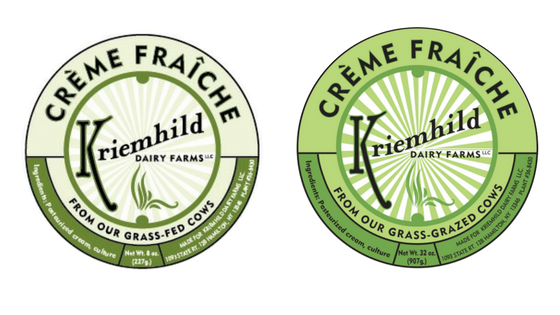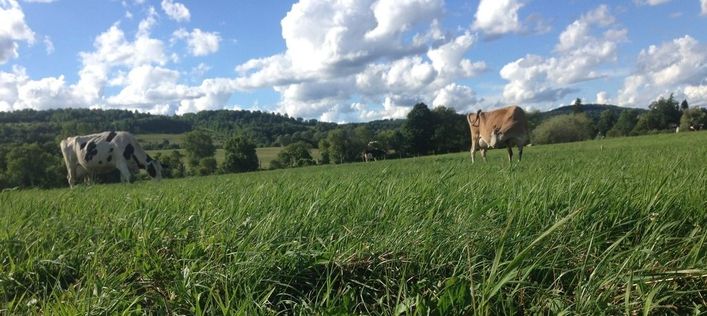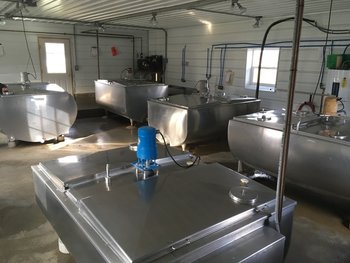Would grass by any other name be as green? | A New-World Commitment and an Old-World Story3/13/2017 The love story of grazing. From the beginning, our labels on both our Meadow Butter and Crème Fraîche have always read: “From our Grass-Fed Cows.” As we have grown from a small local company to one with a wider regional presence, we have and continue to reflect on our labeling choices to ensure that we are communicating clearly and accurately about our products. Recently, two of Kriemhild’s owners attended the 2017 American Grassfed Association Conference (AGA) at The Stone Barns Center for Food and Agriculture. This conference spoke directly to our commitment to the agricultural practice of grazing, and to its impact on creating a better production ecosystem for our farmers, our farmers’ animals, our customers, and our environment. After attending the AGA conference, we felt inspired to make a finer, yet very important, distinction in our labeling. “Grass-Grazed” and “Grass-Fed” As you, our customer, inquires more about the origins of their food, the need for more exacting label standards have grown. In response to the greenwashing free-for-all that has been occurring through American supermarkets, the AGA presented their new 100% Grass-Fed Dairy Standard. This new 100% Grass-Fed Dairy label is the next critical step towards complete transparency and consistency throughout our food system. We at Kriemhild want to honor that industry growth, which is why we are committing to following these new labeling standards. As part of this commitment, we have begun to transition our Crème Fraîche labeling from “Grass-Fed” (the same as we label our Meadow Butter) to be newly distinguished as “Grass-Grazed.” Although having labeled our Crème Fraîche “Grass-Fed” before was not a technical misnomer for the management style of our Crème Fraîche dairy producers, we feel that “Grass-Grazed” is now a more transparent and consistent descriptor. So, what do we mean by Grass-Grazed? The milk for our Crème Fraîche comes from four small Amish family farms in Chenango County, NY. Their cows’ pasture-based diets are supplemented with a portion of hay, Non-GMO corn silage (a ferment) and/or Non-GMO grain depending on the scale of the family’s farm. All of these Crème Fraîche partner farms’ diet plans are greater than 40% pasture grass, which exceeds the 30% minimum set by the National Organic Standard for pasture intake by grazing. So, when you now see “Grass-Grazed” on Kriemhild Crème Fraîche labels, you know that the cows have a diet that consists of a minimum of 40% fresh pasture during the grazing season, and that their diet was supplemented first with hay, then Non-GMO grain or Non-GMO corn silage. As before and as always, our Meadow Butter remains distinguished as a “Grass-Fed” product from cows on a diet of only pasture, hay, and hay ferment. Our Amish Farm Partners: The Origin of your Crème Fraîche New York has the fastest-growing Amish population of all states, and very often, when Amish families settle in NY they buy and rejuvenate old dairy farms. New York state is the third leading producer of dairy products in the United States, and yet from 1990 to 2010, NY lost half of its smaller dairy farms. This decline of family farms has negatively impacted local economies and degraded the rural character and quality of open spaces in upstate New York. Our Amish farm partners play a critical role in reversing this trend, revitalizing neglected farmland and supporting local economies. Eli Hershberger, one of our Amish farm partners, moved to NY with his family when he was 16 years old. He began dairy farming after his brother passed away from a premature heart attack, leaving behind a wife and eight children. Together, this resilient family farms a small herd of 15 milking cows, which are all milked by hand every day. The milk is carried in traditional milk cans to a shared building that houses four large commercial milk tanks, one for each Amish dairy farm we work with. From there, the milk is picked up and trucked to our co-packer facility in Norwich, NY where it is cultured and packaged into your Crème Fraîche. Environmental stewardship is the cornerstone of Amish agricultural practices. If Eli could increase the share of grazing time he gives his cows, he would. At the time being, land and fencing are his largest challenges. Permanent fencing is a significant expense, and given that many Amish avoid using electricity, cheaper temporary electric wire is not an option. Like many farmers, Eli is working the best he can with the resources he has. He is aware that if he supplements too little grain the cows will overgraze the finite pasture he has for them, which causes lasting detrimental effects to the land. In order to assure that his land will be able to produce enough fresh grass throughout the grazing season, Eli gives supplemental non-GMO feed to manage the ecological pressure on his fields. Kriemhild owners, Bruce and Lindsey, inspecting Eli's farm & equipment. Our Commitment
Eli and our other Amish family farms have always produced high quality milk with an ecological and health-centered conscience. We know they will continue to seek excellence in environmental stewardship and animal husbandry, and now you know we just have a better name for their practices: "Grass-Grazed" Dairy. We feel this distinction offers you greater transparency and also consistency with regards to labeling. Our commitment to you to provide ecological, nutritional, and ethical excellence is only stronger with our newly defined terminology, as is our commitment to our local communities and the family farms we partner with.
0 Comments
Leave a Reply. |
As the Butter Churns
Author: Ellen Fagan and Victoria PeilaCategories
All
Archives
November 2019
|
Where our HEart is
|
FOLLOW US |
what our customers are saying"Thank you! Even though I'm 5 hours away...I can't live without you. Got my shipment today.
#kriemhildbutterlove" -- Jennifer in Mystic, Connecticut |
Copyright 2020 © Kriemhild Dairy Farms, LLC










 RSS Feed
RSS Feed